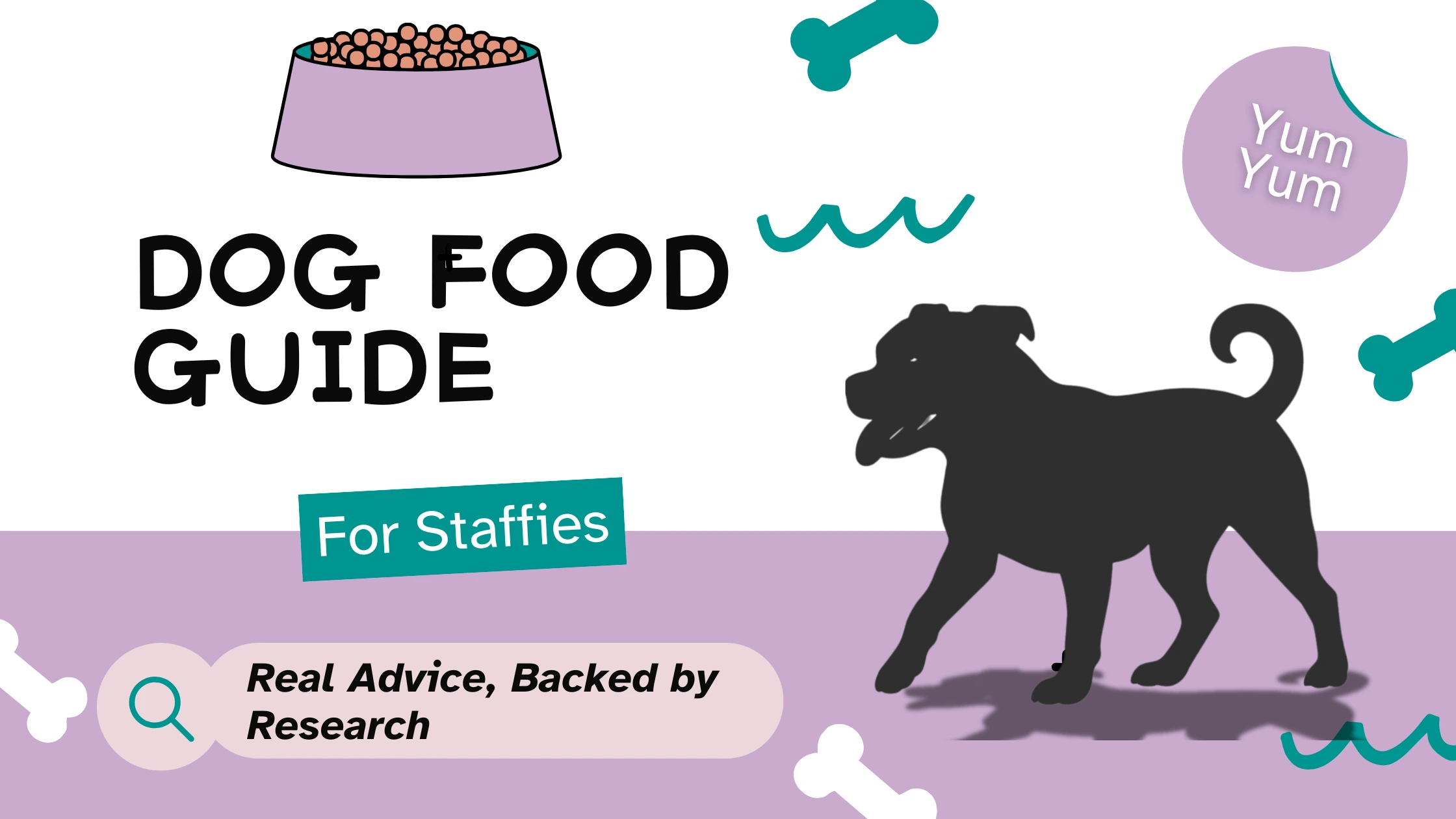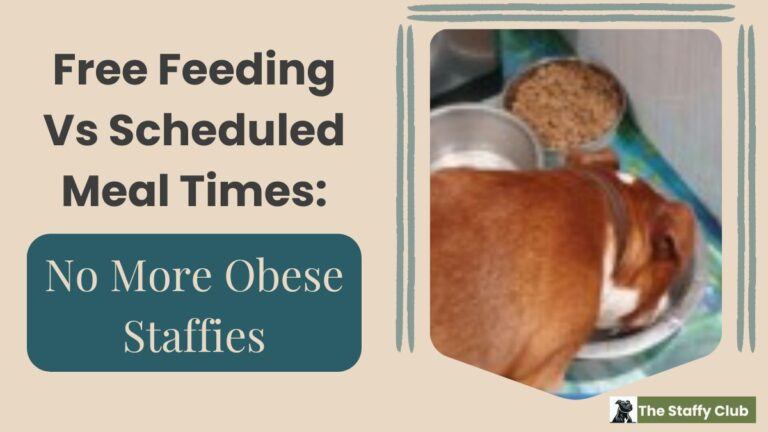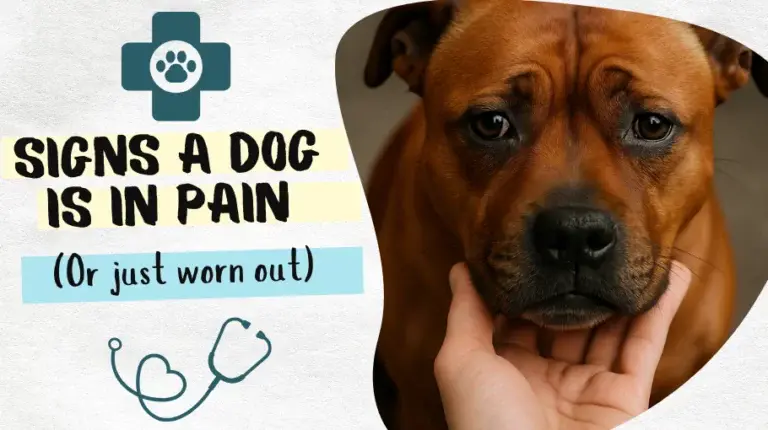Dog Food Guide for Staffies: Real Advice, Backed by Research

Staffordshire Bull Terriers—aka Staffies—are built like tanks and powered like race cars. Muscular, full of beans, and bursting with love. To keep them running at full tilt (without crashing and burning), you need more than any old dog food guide. Something specific that lays out what’s really in food, not just a brand name and a measured scoop amount of kibble to toss into a bowl.
Feeding a Staffy properly means fuelling their energy, keeping their bodies strong, and giving them what they need to age well. It’s not just about “dog food”—it’s about food that supports the way they actually live.
Problem is, the internet is crawling with advice. Every scroll brings a new “expert” pushing miracle diets and overpriced dog dinners. Been there. Scrolled that.
We’ve lived with Staffies for years, and know how overwhelming it can get. That’s why I wrote this dog food guide for Staffie owners—to cut through the noise and give you something useful. No trends, no fluff, just straight-talking info from someone who feeds these dogs every day.
Table of Contents
Understanding What a Staffy Actually Needs (Food-Wise, Not Emotionally—Though, That Too)
Staffies are solid. They’re stocky, strong, and they don’t exactly do things by halves. That means their nutrition needs are a bit different from your average lap dog.
Top priority? Protein.
Muscles don’t build themselves, and Staffies aren’t shy about using theirs. Quality protein keeps them strong, fuelled, and ready to bolt after a squirrel in a blink.
But protein’s just one piece of the puzzle.
You’ll also want:
- Healthy fats (think shiny coat, steady energy)
- A good mix of vitamins and minerals
- Sensible calories that don’t turn your Staffy into a chunky monkey
What the BIG DOGS say:
For European dog owners, the Pet Food Manufacturers’ Association (PFMA) outlines what’s in your dog’s food. They follow guidelines set by the FEDIAF (European Pet Food Industry Federation) and the NRC (National Research Council), ensuring all ingredients meet nutritional standards. Read more here.
For US readers, the Association of American Feed Control Officials (AAFCO) sets the standards for dog food. This includes rules on protein levels and the nutritional value of pet foods. The American Kennel Club (AKC) breaks it down in a more digestible way. Read that here.
Portion Control: The Not-So-Secret Weapon
Even though they’re naturally athletic, Staffies can pile on weight fast if you’re not paying attention. Free-feeding or treat-heavy days can sneak up on you. Before you know it, you’ve got a Staffy who’s more pudding than powerhouse.
Age Matters, Too
Just like humans, their needs change as they age:
- Puppies need extra fuel for all that growing and zooming.
- Adults need a steady, balanced diet to stay strong without overdoing it.
- Seniors? They’re slowing down a bit, so joints and metabolism need more love (and maybe fewer calories).
I was surprised to learn that employing an Animal Nutritionist isn’t a requirement of a pet food manufacturer. There are some, like Hills that have board-certified nutritionists, and others, as noted by the career of David Jackson, founder of All About Dog Food, graduated with a zoology degree and worked as a nutritionist with Burns Pet Nutrition, and The Natural Dog Food Company.
That led me on the path to see what’s actually in the food we’ve always fed our Staffies. (over a decade now)…
Wagg Worker and Budget Foods: Decoded
For clarity on the brand: This is Wagg with the double G, and are part of Inspired Pet Nutrition (IPN). The Wag (with a single G) is an Amazon white-label brand. No experience with it, so can’t comment on it.
As for the Wagg Worker, that’s been a bit of a staple in our house. And yeah—I know it’s one of those brands that gets people talking. Some swear by it, others turn their nose up like their dog’s eating gravel. So, what’s the deal?
At 22% protein, Wagg Worker isn’t trying to be some gourmet, air-dried, yak-cheese-infused superfood. It’s basic. Affordable. Consistent. And in our experience? It does the job.
All our Staffies have been on it their whole lives, mixed in with the odd bit of chicken, cheese, and other ‘human-grade’ odds-n-ends as treats here and there. No upset stomachs. No dull coats. No sluggish energy. Just healthy, happy dogs doing Staffy things—zoomies, licks, and the occasional burst-through-the-door-like-a-cannonball routine.
But what about the ingredients?
Yeah, you’ll hear people bash it for “fillers” or not enough meat content. Fair. It’s not perfect. But if your dog was truly underfed or missing key nutrients, you’d know. Trust me—Staffies are not shy about making a fuss. Ours aren’t raiding bins or begging like they’re on rations (though they will try their luck). They eat, chill, play, and repeat.
That said, we’re not scooping kibble into a bowl and calling it a day. They get extras. Bits of cooked meat, some veg now and then, maybe a splash of fish oil. You can absolutely boost a budget food with simple, real-food add-ons. That’s what makes it work.
So yeah—I’m not here to slap a gold medal on Wagg and declare it the king of all dog foods. But if you’re managing on a budget and still want your dog well-fed? It’s a solid option. Not everyone can—or wants to—spend £80 on a bag of kibble. And that’s okay.
It’s not about buying the trendiest food. It’s about finding what keeps your dog healthy without emptying your bank account. For us, that’s been Wagg. And if it works for you too? Great. If not? Keep testing and tweaking.
If price is high on your research list, here’s a pullquote from another page here:
- Budget-range (wagg): £10–£15 per dog/month
- Mid-range kibble (e.g. Harringtons, Burns): £35–£45
- Premium dry (e.g. Orijen, Acana): £60–£80
- Raw diet (complete meals): £90–£120+
- DIY raw: £60–£90 (depending how you source it)
Behind the Dog Food Label: What You May Not Know
The dog food aisle is a minefield. Glossy bags shouting “premium,” “natural,” and “hypoallergenic” from every shelf. Throw in words like “complete and balanced,” and suddenly you’re wondering if your dog’s dinner is healthier than your own.
Here’s my best go at interpreting the labels.
“Complete and Balanced” Sounds Fancy—But It’s Just a Baseline
That phrase means the food meets minimum nutritional standards. Not exceptional. Not tailored. Just… meets the checklist. Think of it like the dog food version of scraping by with a ‘pass’. It passes, but don’t expect a standing ovation.
Some big-name brands slap that on their packaging, charge you triple, and still fill the bag with ingredients that make you squint. Chicken derivatives? Vegetable by-products? Not exactly five-star dining.
Pricey Doesn’t Always Mean Better
Just because a brand calls itself “premium” doesn’t mean it’s packed with better nutrition. Often, you’re paying for branding, not better food. Don’t fall for the hype. Flip that bag over and look at what’s actually in it.
- Is meat one of the top ingredients?
- Are the additives there for health, or just shelf-life?
- Does it sound like food… or like a chemistry set?
Learn to Read the Label
It’s not about becoming a canine nutritionist overnight. It’s just about knowing when marketing is trying to outsmart you. If you see ingredients you wouldn’t feed yourself—or can’t even pronounce—maybe give that bag a second thought.
Bottom line? Don’t let branding bully you into thinking budget means bad or that expensive means best. Trust your dog. Trust your gut. And read the fine print, not the front of the bag.
Community Voices: What Other Owners Say
While veterinary expertise is invaluable, real-world experiences from Staffy owners often highlight overlooked dietary successes. Industry guidelines like AAHA’s 2021 Nutrition Standards emphasize the need for pet food transparency, yet veterinary training programs often receive undisclosed manufacturer funding.
Everyone’s got their own take on feeding. And honestly? That’s not a bad thing. Because no two dogs are the same—even if they’re both Staffies, both brindle, both named Diesel.
I’ve spoken to owners who swear by budget-friendly options like Wagg. Their dogs are bouncing off the walls (in a good way), have glossy coats, solid poops, and zero issues. Others go the tailored diet route, with raw food, supplements, or subscription meal plans that arrive with the fanfare of a HelloFresh box. That’s cool too—if it works, it works.
The point is: Your dog’s doing the talking.
- Are they energetic?
- Is their coat soft and shiny?
- Are they regular on the healthy stool side?
- Do they act like a total gremlin when they’re hungry—or do they seem content?
Those answers tell you more than any fancy label or internet rant ever will.
It’s also worth saying: don’t let anyone guilt-trip you for not feeding “the best of the best.” Your dog doesn’t need a Michelin star meal. They need food that fuels them, keeps them healthy, and fits your life. And that might look different from the next person’s setup.
Staffy owners are a passionate bunch. We care hard. So hearing how others manage feeding—especially when money, allergies, picky appetites, or time are part of the mix—can be a real help. Just remember to filter opinions through your dog’s reality.
Assessing the Success of Your Staffy’s Diet
So, how do you actually know if your Staffy’s food is doing the job? Spoiler: it’s not about brand names or price tags. It’s about results. And your dog will show you if you’re paying attention.
Here’s what to keep an eye on:
Body condition
You want to feel the ribs, not see them. There should be a visible waist when you look from above, and a tuck-up from the side (kind of like a built-in belt). If your Staffy’s shaped like a barrel, it’s time to check portions—not just blame the biscuits.
Coat and skin
A healthy coat is shiny, soft, and smooth—not greasy or flaky. If their fur’s looking a bit ‘meh’ or there’s more shedding than usual, their food might be missing something. (Or they’re just trying to carpet your house in dog hair. Who knows.)
Energy levels
Staffies naturally have bounce. If they’re suddenly sluggish or acting like they’ve hit snooze on life, it could be a food issue. Same goes for wild hyperactivity—that sugar-rush behaviour might mean too many carbs and not enough real fuel.
Poop watch (yeah, we’re going there)
Firm, easy-to-pick-up poos? All good. Runny, weird-coloured, or foul-smelling ones? That’s your dog’s way of saying “Mate, this isn’t working.” You learn a lot from what comes out the other end. Gross but true.
If something feels off—don’t panic. It might just be a tweak that’s needed. Switch up the protein source, adjust the portion size, or add in a bit of fresh food. And when in doubt, have a chat with your vet. They’ll help rule out anything medical and give solid direction if it’s just a dietary mismatch.
Feeding isn’t “set and forget.” It’s a moving target as your dog grows, ages, or goes from couch potato to park sprinter. Stay curious, stay flexible, and your Staffy will thank you with wags, zoomies, and fewer vet visits.
Final Reflections: A Personalised Approach
Feeding your Staffy isn’t about chasing trends or following one-size-fits-all rules. It’s about finding what works for your dog—and for you.
Maybe that’s Wagg. Maybe it’s chicken and rice. Maybe it’s a mix of kibble and kitchen scraps (hey, we’ve all dropped a chip or two). What matters is that your dog’s thriving. They’ve got energy, a shiny coat, healthy digestion, and they’re not side-eyeing the food bowl like it owes them money.
There’s no perfect food—just the one that works.
I’m not here to say Wagg is the holy grail of dog food. It works for our dogs, full stop. I know what’s in it, I know how they respond to it, and I know I can afford to keep them fed and happy on it – for the long-haul. That’s a win in my book. Dogs don’t take easily to diet switches.
But if it doesn’t suit yours? No drama. There’s room in the dog-owning world for different diets, different needs, and different budgets. You’re not failing your dog because you’re not feeding the top-shelf stuff with gold flakes and a side of activated quinoa.
What your Staffy needs is consistency, good nutrition, and a bit of common sense. Keep an eye on how they’re doing, be ready to make changes when needed, and trust that you know your dog better than any label does.
So yeah—fancy food or budget bag, raw or kibble, supplements or none—the goal’s the same: a healthy, happy Staffy who’s ready for belly rubs, zoomies, and whatever else life throws their way.
Practical FAQs for Staffy Owners
Is 20% protein enough for a Staffy?
Yes, 20% protein is a solid baseline for most healthy adult Staffies. It supports muscle maintenance, especially when paired with real-food extras like meat, fish, or eggs.
Should I supplement dry dog food with fresh food?
Yes. Adding fresh foods like lean meat, eggs, or veg boosts nutrition and can improve digestion, coat health, and energy levels.
How many times a day should I feed my Staffy?
Twice daily is ideal for adult Staffies & 3 x a day for pups.
What if my Staffy won’t eat their food?
Try adjusting flavours or adding real food. If that doesn’t help, check with a vet to rule out illness, pain, or dental issues.
Can I free-feed my Staffy?
You absolutely can. All our Staffies have always been free-fed. However, rescues may struggle with it, especially if they’ve had past experiences where food wasn’t guaranteed. They might eat more than they need out of insecurity. But, if done right, free-feeding can work. I’ve actually written a post about it here: Free-feeding vs. Scheduled Meals.
How do I know if my Staffy’s food is working?
Watch for high energy, a shiny coat, solid poops, and a healthy weight. If all’s well on those fronts, the food is doing its job.
How do I switch my Staffy’s food without upsetting their stomach?
Gradually mix the new food with their old food over 7-10 days. Start with 25% new food, increasing each day. If your Staffy gets a stomach upset, adding a probiotic can help ease digestion during the transition.






